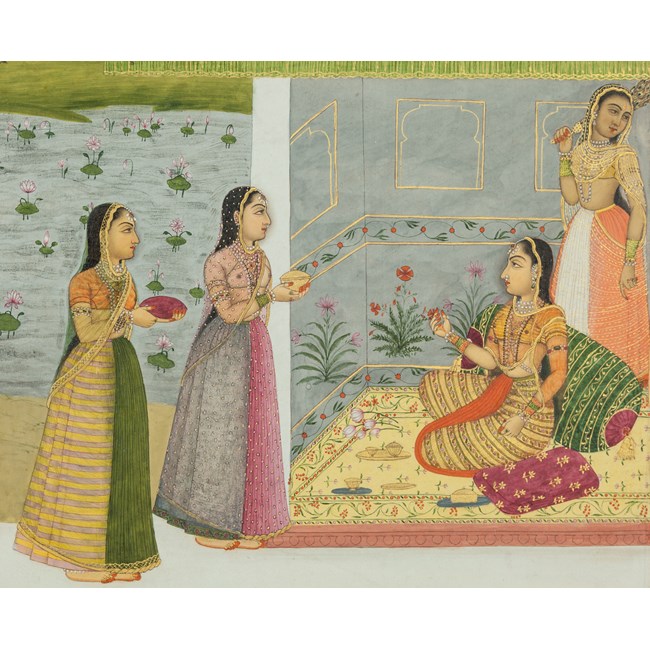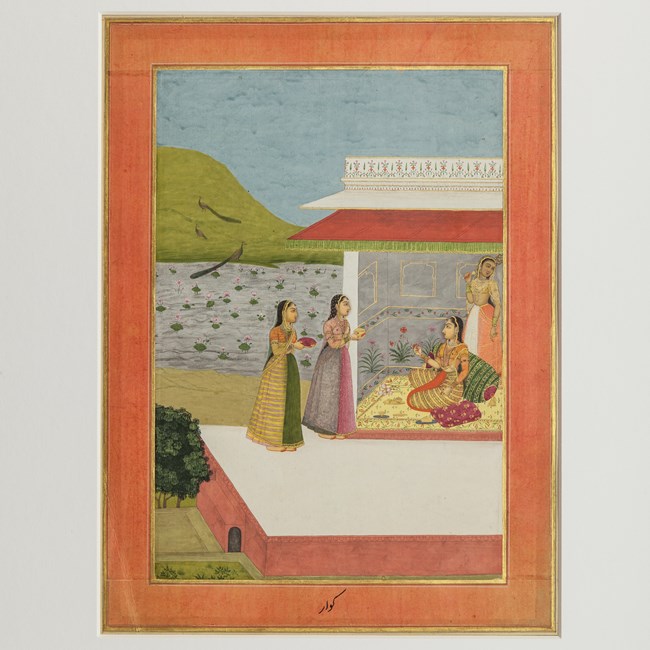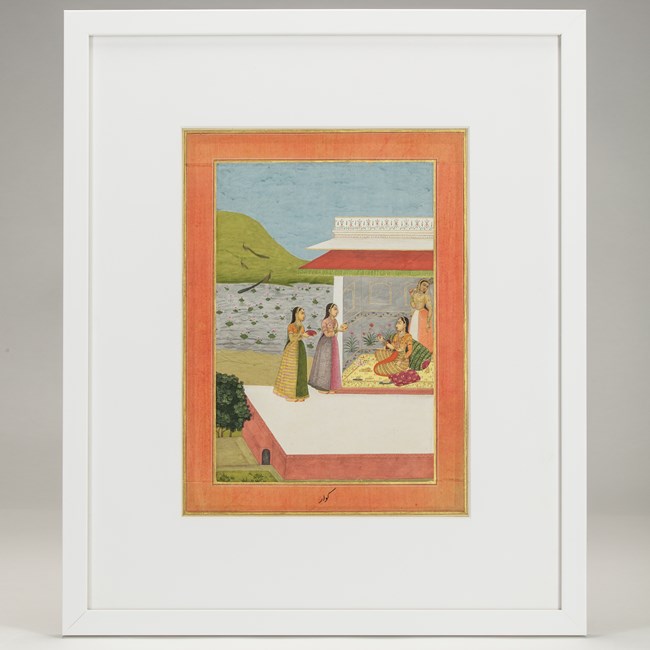
Ladies Gather at Riverside Pavilion
Ladies Gather at Riverside Pavilion
Provincial Mughal, India circa 1740-60
Opaque watercolour heightened with gold on paper
30cm high, 23cm wide
Provenance: Private French collection
Exhibited in " Miniature Orientales De L'Inde" Paris, May 1973
Stock no.: A4314
Ladies Gather at Riverside Pavilion
A clear blue sky, rolling hills and a gently flowing river, dappled with lotus blossoms, sets this eloquent scene as a group of women gather at a pavilion. Two female attendants cross the cool marble floor to present offerings to a woman resting against a green bolster on a pale yellow carpet. Acknowledging their gifts, she offers her right hand in a gesture of receiving. All the women wear elegant full skirts (ghagras), sheer blouses (cholis) and veils (odhanis) edged in fine gold ribbon. Bedecked in pearl necklaces, precious stone armlets (bazubands) and radiant headpieces (tikkas), their status is implicit. This sumptuous exuberance is enhanced by the silk carpet, gold niches and delicate floral sprays, which decorate the interior of the pavilion. While the prevailing mood evokes a pastoral tranquillity, subtle indications allude that all is not as it may seem. Across the river peacocks gaze anxiously toward the far right, suggesting an imminent presence. The uneasy gestures of the birds are echoed by the attendant in the pavilion, holding a peacock feather fan, (morchal). Neglecting her duties, she gazes wistfully over her shoulder as she casts her eyes to the right. Her slender finger points downwards toward the carpet on which her mistress presides and significantly the vacant cushion beside her. In ragamala paintings (visual expressions of musical modes), the peacock often appears as a metaphor for an absent lover, such as Krishna. The morchal is also emblematic of Krishna as it represents the feathers of his crown. Nayikas or heroines frequently appear in ragamala paintings, symbolising their relationship with the hero or nayaka. They enabled artists to convey various rasas (emotional sentiments). The cluster of lotus blossoms beside the woman in the pavilion alludes to the story of Gauri Ragini, in which the heroine picks flowers, as she awaits the return of her lover. Thus the mood of vipralambha (love in separation) is evoked. During the mid eighteenth century, formal portraiture was succeeded in popularity by idealised compositions and ragamala paintings. Artists such as Muhammad Faqirallah Khan were influenced by the ragamala aesthetic. His paintings are typified by elegant women with small rosebud lips, defined noses and distinctive shading around their hair and jawlines. He worked as an eminent painter in Muhammad Shah’s court. Known as Rangila (pleasure lover), Muhammad Shah amassed an active atelier of artists and poets. However, between Nadir Shah’s invasion of Delhi in 1739 and Muhammad Shah’s death in 1748, many artists fled the city seeking patronage elsewhere. During this period Faizabad and Lucknow, the successive capitals of Oudh, emerged as major creative centres. Faqirallah Khan and his brother Faizallah both spent time in Farrukhabad, Faizabad and Lucknow, where they influenced other artists with their distinctive style. During the 1750s Faqirallah is also known to have collaborated with Fath Chand on a dispersed ragamala series, an example of which is contained at the British Library (Kakubha Ragini, Add.Or.485). The stylistic influence of Fath Chand and the Khan brothers may be identified in the current work. A preference for elegant women supporting long ghagras and immodestly covering their upper bodies with translucent fabric is typical among their repertoire. In this instance, the artist has also successfully appropriated their sensitive modelling and employment of delicate shading, adding volume to the women’s features. As the heroine pining for her lover, the artist himself may have experienced longing, driven to seek patronage in an unfamiliar city. By taking the time to familiarise ourselves with this painting, we are rewarded by the revelation of its subtle complexities. The rich Mughal aesthetic, interlaced with delicate Hindu sentiment, culminates in a work that simultaneously quenches our thirst for the sublime and the visceral.
@AMIRMOHTASHEMI








 instagram
instagram
